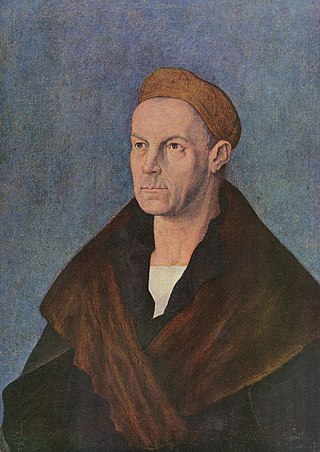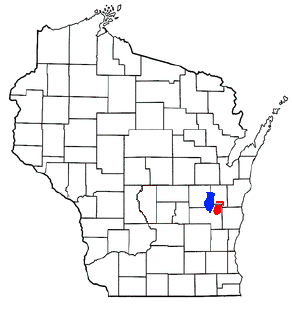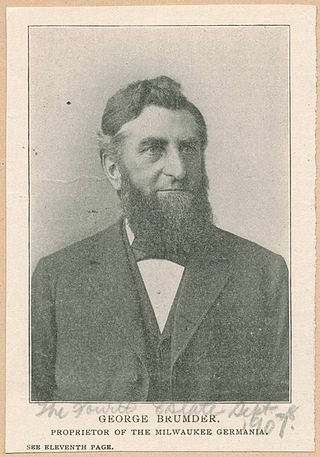
John Jacob Astor was a German-born American businessman, merchant, real estate mogul, and investor. Astor made his fortune mainly in a fur trade monopoly, by exporting opium into China, and by investing in real estate in or around New York City. He was the first prominent member of the Astor family and the first multi-millionaire in the United States.

Jakob Ammann was a Swiss Anabaptist leader and the namesake of the Amish religious movement.

Johann Gottlieb Friedrich "Frederick" Pabst was a German-American brewer for whom the Pabst Brewing Company was named.

German Americans are Americans who have full or partial German ancestry.

Jakob Böhme was a German philosopher, Christian mystic, and Lutheran Protestant theologian. He was considered an original thinker by many of his contemporaries within the Lutheran tradition, and his first book, commonly known as Aurora, caused a great scandal. In contemporary English, his name may be spelled Jacob Boehme ; in seventeenth-century England it was also spelled Behmen, approximating the contemporary English pronunciation of the German Böhme.

Jacob Henry Schiff was an American banker, businessman, and philanthropist. He helped finance the expansion of American railroads and the Japanese military efforts against Tsarist Russia in the Russo-Japanese War.
Isaac ben Moses of Vienna, also called Isaac Or Zarua or the Riaz, is considered to be one of the prominent rabbis of the Middle Ages. He was probably born in Bohemia and lived between 1200 and 1270. He attained his fame in Vienna and his major work, the halachic guide known as the Or Zarua a compilation of halachic decisions and legal rulings, was very popular among Ashkenazic Jewry. He was a member of the Ashkenazi Hasidim and studied under many scholars, including Eliezer ben Joel HaLevi, Judah ben Samuel of Regensburg, Samson of Coucy and Eleazar of Worms. He was among the teachers of Meir of Rothenburg.

Jakob Fuggerof the Lily, also known as Jakob Fuggerthe Rich or sometimes Jakob II, was a major German merchant, mining entrepreneur, and banker. He was a descendant of the Fugger merchant family located in the Free Imperial City of Augsburg. He was born and later also elevated through marriage to Grand Burgher of Augsburg. Within a few decades, he expanded the family firm to a business operating in all of Europe. He began his education at the age of 14 in Venice, which also remained his main residence until 1487. At the same time, he was a cleric and held several prebends. Even though he lived in a monastery, Jakob found time to study the history of investment in early Asian markets. American journalist Greg Steinmetz has estimated his overall wealth to be around $400 billion in today's money, equivalent to 2% of the GDP of Europe at that time.
Dr. h.c. Max Kade was an emigrant from Germany to New York City who became successful in the pharmaceutical industry. Kade was committed to advancing German-American relations. He established a foundation in New York to promote scientific and technical progress and to further the peaceful coexistence of nations.

Richard Beer-Hofmann was an Austrian dramatist and poet.

John Jacob Bausch was a German-American maker of optical instruments who co-founded Bausch & Lomb. Over six decades he transformed his small, local optical shop into a large-scale international enterprise, pioneering the American optical industry.

Henry William Stiegel was a German-American glassmaker and ironmaster.

Sanford J. "Sandy" Ungar is an American journalist, author, and the inaugural director of the Free Speech Project at Georgetown University. He was the tenth president of Goucher College and the 24th director of Voice of America.

An autograph book is a book for collecting the autographs of others. Traditionally they were exchanged among friends, colleagues, and classmates to fill with poems, drawings, personal messages, small pieces of verse, and other mementos. Their modern derivations include yearbooks, friendship books, and guest books. They were popular among university students from the 15th century until the mid-19th century, after which their popularity began to wane as they were gradually replaced by yearbooks.

Temple Adas Israel is an historic Reform Jewish synagogue located at the intersection of Washington and College streets in Brownsville, West Tennessee. Built in 1882 by German Jewish immigrants and descendants, it is the oldest synagogue building in Tennessee and one of fewer than one hundred surviving 19th-century synagogues in the country. On January 19, 1979, Temple Adas Israel was added to the National Register of Historic Places.

The Holyland is an American region located mainly in northeastern Fond du Lac County, Wisconsin and southern Calumet County. The area is known for its distinctive agricultural landscape, a close-knit community life, and deep Roman Catholicism brought by Germans who first settled the region in the 1840s. The area has been studied as an example of chain migration. It has been called "The Holyland" since at least 1898.

George Brumder was a German-American newspaper publisher and businessman in Milwaukee, Wisconsin. Born in Breuschwickersheim, Bas-Rhin, France, Brumder emigrated to the United States, settling in Milwaukee, where he established the largest publishing company of German-American materials in the United States.
The La Guardia and Wagner Archives was established in 1982 at LaGuardia Community College in Long Island City, Queens, New York, to collect, preserve, and make available primary materials documenting the social and political history of New York City, with an emphasis on the mayoralty and the borough of Queens. The purpose of its founding went beyond serving as a repository, but to establish the college as a location for scholarly research. The archives serves a broad array of researchers, journalists, students, scholars, exhibit planners, and policy makers. Its web site provides guidelines to the collections, as well as over 55,000 digitized photographs and close to 2,000,000 digitized documents.

Florence Mendheim was a New York Public Library branch librarian notable for her undercover surveillance of American Nazi groups in the pre-World War II 1930s. She was the daughter of German-Jewish immigrants and an observant Jew who practiced kosher dietary laws. Her personal papers, including documentation of her spy activities, are housed in the archives of the Leo Baeck Institute in New York.

The term Wisconsin German refers to both Wisconsin High German and to heritage dialects of German spoken in Wisconsin. By 1853, a third of Wisconsin's population was coming from German-speaking lands; by the end of the 19th century, Wisconsin's largest minority of non-English speakers were German speakers. Unlike other heritage languages, which tend to become moribund by the third generation, Wisconsin German speakers have maintained their heritage language(s) alongside English for multiple generations, from the 1840s to well until the mid-20th century. This is due in part to their immigration patterns: the German immigrants tended to settle within ethnically homogeneous communities, with similar linguistic, cultural, and geographic backgrounds. Additionally, the maintenance of the language was supported by German being taught and used in many local churches, schools, and the press. While Wisconsin German retains many standard and/or dialectal features of German, it has not only incorporated some linguistic elements of English, but also developed unique and innovative characteristics of its own. By the early mid-20th century, social, political and economic factors such as urbanization and severe persecution during World War I, contributed to a general shift from German to English.

















